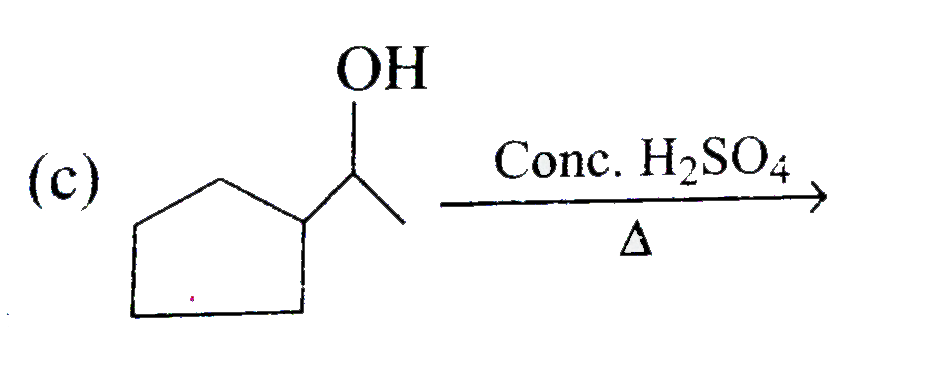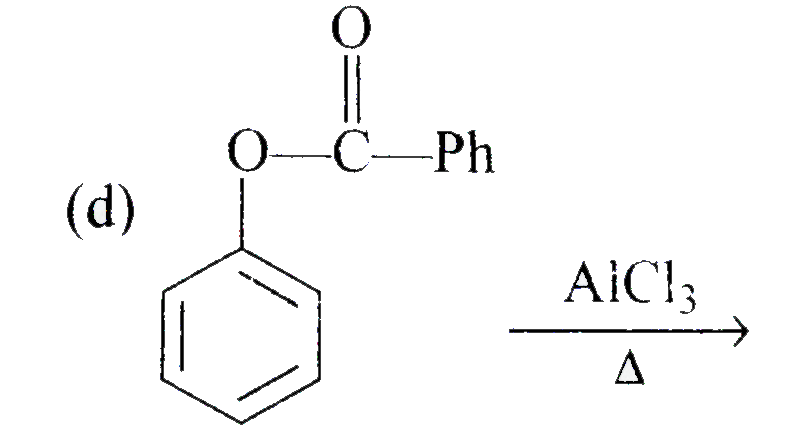Explore topic-wise InterviewSolutions in .
This section includes InterviewSolutions, each offering curated multiple-choice questions to sharpen your knowledge and support exam preparation. Choose a topic below to get started.
| 19051. |
Which among the following sets of reactatns will produce anisole? |
|
Answer» HCHO, RMgX |
|
| 19052. |
The reduction electrode potential E of 0.1 M solution ofM^+ ions(E^o(rp) = -2.36V ) is : |
|
Answer» `-2.41` |
|
| 19053. |
Which one of the following nitro-compounds does not react with nitrous acid ? |
|
Answer»
|
|
| 19054. |
Which of the following is a condensation polymer: |
|
Answer» Polystyrene |
|
| 19055. |
Which of the following can be used as local anaesthetic: |
|
Answer» `CHCl_3` |
|
| 19056. |
What is Bessemerisation ? |
| Answer» SOLUTION :It is the process of extraction of COPPER from copper PYRITE ORE. | |
| 19057. |
Which of the following is an example of aldol condensation : |
|
Answer» `2CH_3CHOoverset (DIL NAOH) RARR ch_3CHOHC_2CHO` |
|
| 19058. |
White phosphorus reacts with chlorine and the product hydrolyses in the presence of water. Calculate the mass of HCl obtained by the hydrolysis of the product formed by the reaction of 62 g of white phosphorus with chlorine in the presence of water. |
|
Answer» Solution :`underset(1 mol)(P_(4) + 6Cl_(2)) + 12H_(2)O to 4H_(3)PO_(3) + underset(12 "mol")(12HCl)` `therefore 0.5` mol `therefore` Moles of HCl obtained `=12 xx 0.5 = 6` `therefore` MASS of HCl obtained = Moles x Mol. Mass `=6 xx 36.5` `=219.0` g |
|
| 19059. |
Which among the following comjpounds will give a secondary alcohol on reacting with Grignard reagent followed by acid hydrolysis? I. HCHO II. C_(2)H_(5)CHO III. CH_(3)COOCH_(3) IV. RCOOC_(2)H_(5) Select the correct answer using the codes given below: |
|
Answer» Only II 
|
|
| 19060. |
Which one of the following is an amor- phous solid ? |
| Answer» Solution :Glass | |
| 19061. |
The tetrahedral crystal field splitting is only of the octahedral splitting: |
|
Answer» `1//9` |
|
| 19062. |
What is the role of ZnCl_(2) in dry cell? |
| Answer» Solution :`ZnCl_(2)` COMBINES with the `NH_(3)` produced to form the COMPLEX salt `[Zn(NH_(3))_(2)Cl_(2)]` as otherwise the pressure developed DUE to `NH_(3)` would crack the SEAL of the cell. | |
| 19064. |
Vapour density of a gas is 11.2. The volume occupied by 11.2 g of gas at NTP is |
|
Answer» 22.4 litre |
|
| 19065. |
Which one of the following is paramagnetic in nature? |
| Answer» Solution :`Cu^(2+)` | |
| 19066. |
What are the applications of Kohlrausch's law ? |
|
Answer» Solution :Applications of KOHLRAUSCH's law : (1) It can be used to evaluate the molar conductivity of any electrolyte at infinitedilution or zero concentrationwhich cannot be exprimentally measured. (2)` wedge_(0)` for weak electrolytes can be obtained from `wedge_(0)` values of strong electrolytes involvingsimilar cations or anions. (3) Ionic PRODUCT of water `(K_(omega))`, solubility and solubility product of sparingly soluble electrolytes can be CALCULATED. (4) Degree of dissociation of weak electrolytes can be calculated from `wedge_(0)` values. |
|
| 19068. |
Which of the following is an endothermic reaction |
|
Answer» `2H_(2)+O_(2)rarr2H_(2)O` |
|
| 19069. |
Which of the following method produce cyclopentanone as the major product |
|
Answer»

|
|
| 19070. |
What is Hinsberg reagent? |
| Answer» Solution :Benzenesulphonyl CHLORIDE `(C_(6)H_(5)SO_(2)Cl)` is called Hinsberg's reagent. | |
| 19071. |
The standard electrode potentials of some electrodes are : {:("Electrode",Zn^(2+)"|"Zn,Cd^(2+)"|"Cd,Ag^(+)"|"Ag,Fe^(2+)"|"Fe),(E^(@)(V),-0.76,-0.40,0.80V,-0.44V):}Which of the following cells are feasible and give their E^(@) cell ? (i) Zn|Zn^(2+)||Cd^(2+)|Cd(ii)Fe|Fe^(2+)||Zn^(2+)|Zn (iii)Cd|Cd^(2+)"||"Ag^(+) (iv) Fe|Fe^(2+)"||"Ag^(2+)|Ag |
|
Answer» (i) , (iii) , (IV) (ii) Not feasible , `E^(@)=-0.32V` (iii)Feasible ,`E^(@)=+1.20V` (iv)Feasible , `E^(@)=+1.24V` so, OPTION (A) us correct |
|
| 19072. |
Which name is given to spatial arrangements in coordination compounds ? |
| Answer» SOLUTION :Polyhadra | |
| 19074. |
What will be the vapour pressure of solution prepasred by dissolving 18 gram Glucose to 178.2 gram water ? |
|
Answer» 759.00 MM ` THEREFORE (P^(@)-P)/(P^(@))=(W xx M_(0))/(M xx W_(0))` |
|
| 19075. |
Which of the following compounds show optical isomerism ? (P) cis-[Co(NH_(3))_(4)Cl_(2)]^(+)""(Q) "trans"-[Co(en)_(2)Cl_(2)]^(+) (R ) cis-[Co(en)_(2)Cl_(2)]^(+)""(S) [Co(en)_(3)]^(3+) select the correct answer using the codes given below : |
|
Answer» <P>P and Q |
|
| 19076. |
Which one of the following properties is more applicable to alkaline earth metals compared with alkali metals ? |
|
Answer» GREATER IONIC radii |
|
| 19077. |
Which of the following statement is correct for a lyophilic solution? |
|
Answer» It is not EASILY solvated |
|
| 19078. |
Which of the following reaction is not possible |
|
Answer» `C_2H_5-O-C_2H_5 overset(Na)to` |
|
| 19079. |
Under identical conditions, the S_(N^(1)) reaction will occur most efficiently with |
|
Answer» Tert-butyl chloride `underset("1-chlorobuta ne")(CH_(3)-CH_(2)-CH_(2)-CH_(2)-Cl)` `underset("2-methyl-1-chloroprop ANE")(CH_(3)-underset(CH_(3))underset(|)(C)H-CH_(2)Cl)""underset("2-chlorobutane")(CH_(3)-CH_(2)-underset(Cl)underset(|)(C)H-CH_(3))`. As t-butyl chloride will form `3^(@)` carbocation which is most stable THUS `S_(N^(1))` REACTION will occur most efficiently with t-butyl chloride. |
|
| 19080. |
Tollen's reagent is |
|
Answer» AQUEOUS copper sulphate |
|
| 19081. |
How is phosphine prepard in the laboratory? |
|
Answer» <P> SOLUTION :White phosphorousPhosphire is prepared by heating white phosphorous with conc. `NAOH` in inert atmosphere of `CO_(2)`. `P_(4)+3NaOH+3H_(2)Orarr PH_(3)+3NaH_(2)PO_(2)` |
|
| 19082. |
The shape of XeF_(3)^(+) is : |
|
Answer» TRIGONAL PLANAR 
|
|
| 19083. |
What are the uses of ethanol. |
|
Answer» SOLUTION :1. Ethanol is used as an important BEVERAGE. 2. It is also used in the PREPARATION of (a) Paints and varnishes (B) Organie compounds like ether, chloroform, iodoform, etc., (c) Dyes, transparent soaps. 3. As a substitute for petrol under the name power alcohol used as fuel for aeroplane 4. It is used as a preservative for biological specimens. |
|
| 19084. |
What is the oxidation state in coordination compound ? |
|
Answer» Solution :The oxidation STATE of a central metal atom in a coordination entity is defined as the charge it would bear if all the lighands were removed along with the ELECTRON pairs that were shared with the central atom. In naming a COMPLEX, it is represented by a Roman numeral. For e.g., in coordination entity `[FE(CN)_(6)]^(4-)` the oxidation state of iron is represented as (II). In `[Fe(CN)_(6)]^(4-)`, let the oxidation number of iron is The NET charge `=-4` `x+6(-1)=-4` `x-6=-4` `x=6-4=+2` So, iron oxidation state (II). |
|
| 19085. |
What is the formula of compound present in brown ring? |
|
Answer» SOLUTION :`3FE^(2+)+NO_(3)^(ɵ)+4H^(o+)to3Fe^(2+)+NO+2H_(2)O` `FeSO_(4)+NOtoFeSO_(4).NO` or `[Fe(H_(2)O)_(5)NO]SO_(4)` |
|
| 19086. |
Which of the following will decreases the pH of a 50 ml solution of 0.01 M HCl |
|
Answer» Addition of 5 ml of 1 M HCL |
|
| 19087. |
Which of the following metals has been used in making boats because it has resistance to corrosion by sea water ? |
|
Answer» W |
|
| 19088. |
Which one of the following contain isopropyl group ? |
|
Answer» 2,2,3,3-tetramethyl pentane  It CONTAINS ISOPROPYL GROUP. |
|
| 19089. |
Which one of the following is an example for homogeneous catalysis? |
|
Answer» MANUFACTURE of sulphuric acid by CONTACT process |
|
| 19090. |
What are emulsions? |
| Answer» Solution :(i) Emulsions are liquid - liquid colloidal SYSTEMS. (ii) If a MIXTURE of two immiscible or partially miscible LIQUIDS are shaken, a coarse dispersion of one liquid in the other is OBTAINED which is called EMULSION, Eg: In milk, liquid fat is dispersed in water. | |
| 19091. |
Which one of the following should be most stable |
| Answer» Solution :`H^(-)` is most stable due to its FULL filled 1s-orbital. | |
| 19092. |
Which one of the elements is not found in nature? |
|
Answer» Radium |
|
| 19093. |
Write the formula and IUPAC name of aspirin. |
Answer» SOLUTION :
|
|
| 19094. |
Which of the following process is not associated with steel making? |
|
Answer» BESSEMER process |
|
| 19095. |
What is the difference between analgesics and anaesthetics? |
| Answer» Solution :ANALGESICS are medicines used to reduce pain of any kind in the BODY while ANAESTHETICS are medicines GIVEN to the patient so that he does not feel pain during OPERATION. | |
| 19096. |
When iodine reacts with NaF, NaBr and NaCl: |
|
Answer» It GIVES MIXTURE of `F_2 , Cl_2 and Br_2` |
|
| 19097. |
What is observed when tertiary alcohol is subjected to Lucas test ? |
|
Answer» Oily droplets on the UPPER surface |
|
| 19098. |
When two reactants A& B are mixed to give products C & D the reaction quotient Q, at the initial stages of the reaction. |
|
Answer» is zero |
|
| 19099. |
ZnO can be reduced to the metal by heating with carbon but not Cr_(2)O_(3).Justify your answer. |
| Answer» Solution :Carbon has more affinity for oxygen than ZINC, whereas chromium has higher affinity for oxygen than zinc. HENCE `ZNO` can be reduced to the metal by HEATING with carbon but not `Cr_(2)O_(3)`. | |
| 19100. |
What is a polypeptide ? Give one example. |
| Answer» SOLUTION :Polypeptides are formed when several molecules of `alpha`-AMINO ACIDS are joined together by peptide bonds , For example , oxytocin is a nanopeptide , i.e., CONTAINS 9 `alpha`-amino acid UNITS while insulin contains 51 `alpha`-amino acid units. | |









